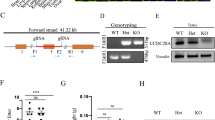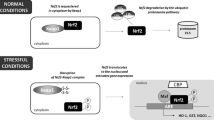Abstract
Zinc finger proteins (ZFPs) that contain multiple cysteine and/or histidine residues perform important roles in various cellular functions, including transcriptional regulation, cell proliferation, differentiation, and apoptosis. The Cys–Cys–His–His (C2H2) type of ZFPs are the well-defined members of this super family and are the largest and most complex proteins in eukaryotic genomes. In this study, we identified a novel C2H2 type of zinc finger gene ZNFD from mice which has a 1,002 bp open reading frame and encodes a protein with 333 amino acid residues. The predicted 37.4 kDa protein contains a C2H2 zinc finger domain. ZNFD gene is located on chromosome 18qD1. RT-PCR analysis revealed that the ZNFD gene was specifically expressed in mouse testis but not in other tissues. Subcellular localization analysis demonstrated that ZNFD was localized in the nucleus. Reporter gene assays showed that overexpression of ZNFD in the COS7 cells activates the transcriptional activities of heat shock element (HSE). Overall, these results suggest that ZNFD is a member of the zinc finger transcription factor family and it participates in the transcriptional regulation of HSE. Many heat shock proteins regulated by HSE are involved in testicular development. Therefore, our results suggest that ZNFD may probably participate in the development of mouse testis and function as a transcription activator in HSE-mediated gene expression and signaling pathways.






Similar content being viewed by others
References
Koh DI et al (2009) A novel POK family transcription factor, ZBTB5, represses transcription of p21CIP1 gene. J Biol Chem 284:19856–19866
Dai KS, Liew CC (1999) Chromosomal, in silico and in vitro expression analysis of cardiovascular-based genes encoding zinc finger proteins. J Mol Cell Cardiol 31:1749–1769
Schuh R et al (1986) A conserved family of nuclear proteins containing structural elements of the finger protein encoded by Kruppel, a Drosophila segmentation gene. Cell 47:1025–1032
Drummond IA et al (1992) Repression of the insulin-like growth factor II gene by the Wilms tumor suppressor WT1. Science 257:674–678
Calderwood SK et al (2009) The shock of aging: molecular chaperones and the heat shock response in longevity and aging—a mini-review. Gerontology 55:550–558
Romano CC et al (2004) Commonly used antibiotics induce expression of Hsp 27 and Hsp 60 and protect human lymphocytes from apoptosis. Int Immunopharmacol 4:1067–1073
Ding XZ et al (2010) HSP-70 mitigates LPS/SKI-induced cell damage by increasing sphingosine kinase 1 (SK1). Prostaglandins Other Lipid Mediat 92:1–7
Somji S et al (2002) Expression of hsp 90 in the human kidney and in proximal tubule cells exposed to heat, sodium arsenite and cadmium chloride. Toxicol Lett 133:241–254
Arrigo AP (2000) sHsp as novel regulators of programmed cell death and tumorigenicity. Pathol Biol (Paris) 48:280–288
Rockett JC et al (2001) Effects of hyperthermia on spermatogenesis, apoptosis, gene expression, and fertility in adult male mice. Biol Reprod 65:229–239
Mezquita B et al (2001) Constitutive and heat-shock induced expression of Hsp70 mRNA during chicken testicular development and regression. J Cell Biochem 82:480–490
Lei C et al (2010) Isolation and characterization of a novel zinc finger gene, ZNFD, activating AP1(PMA) transcriptional activities. Mol Cell Biochem 340:63–71
Jeon BN et al (2009) ZBTB2, a novel master regulator of the p53 pathway. J Biol Chem 284:17935–17946
Puccetti E et al (2002) AML-associated translocation products block vitamin D(3)-induced differentiation by sequestering the vitamin D(3) receptor. Cancer Res 62:7050–7058
Weber A et al (2008) Zbtb4 represses transcription of P21CIP1 and controls the cellular response to p53 activation. EMBO J 27:1563–1574
Fahnenstich J et al (2003) Promyelocytic leukaemia zinc finger protein (PLZF) is a glucocorticoid- and progesterone-induced transcription factor in human endometrial stromal cells and myometrial smooth muscle cells. Mol Hum Reprod 9:611–623
Borjigin U et al (2010) Expression of promyelocytic leukaemia zinc finger in ovine testis and its application in evaluating the enrichment efficiency of differential plating. Reprod Fertil Dev 22:733–742
de Luis O et al (1999) Tex27, a gene containing a zinc finger domain, is up-regulated during the haploid stages of spermatogenesis. Exp Cell Res 249:320–326
Kumar R et al (2006) ZNF652, a novel zinc finger protein, interacts with the putative breast tumor suppressor CBFA2T3 to repress transcription. Mol Cancer Res 4:655–665
Kumar R et al (2008) CBFA2T3-ZNF652 corepressor complex regulates transcription of the E-box gene HEB. J Biol Chem 283:19026–19038
Yanai I et al (2004) Incongruent expression profiles between human and mouse orthologous genes suggest widespread neutral evolution of transcription control. OMICS 8:15–24
Fenton WA, Horwich AL (1997) GroEL-mediated protein folding. Protein Sci 6:743–760
Sorger PK, Pelham HR (1988) Yeast heat shock factor is an essential DNA-binding protein that exhibits temperature-dependent phosphorylation. Cell 54:855–864
Widlak W et al (2007) Heat shock transcription factor 1 down-regulates spermatocyte-specific 70 kDa heat shock protein expression prior to the induction of apoptosis in mouse testes. Genes Cells 12:487–499
Erata GO et al (2008) The role of heat shock protein 70 (Hsp 70) in male infertility: is it a line of defense against sperm DNA fragmentation? Fertil Steril 90:322–327
Govin J et al (2006) Post-meiotic shifts in HSPA2/HSP70.2 chaperone activity during mouse spermatogenesis. J Biol Chem 281:37888–37892
Held T et al (2006) Hspa4 l-deficient mice display increased incidence of male infertility and hydronephrosis development. Mol Cell Biol 26:8099–8108
Acknowledgments
This study was supported by the grant from the National Natural Science Foundation of China (Grant 30700826 and Grant 81071957) and the Natural Science Foundation of the Jiangsu Higher Education Institutions of China (08KJA230001).
Author information
Authors and Affiliations
Corresponding authors
Additional information
F. Xu and W. Wang have contributed equally to this study.
Rights and permissions
About this article
Cite this article
Xu, F., Wang, W., Lei, C. et al. Activation of transcriptional activity of HSE by a novel mouse zinc finger protein ZNFD specifically expressed in testis. Mol Cell Biochem 363, 409–417 (2012). https://doi.org/10.1007/s11010-011-1193-7
Received:
Accepted:
Published:
Issue Date:
DOI: https://doi.org/10.1007/s11010-011-1193-7




